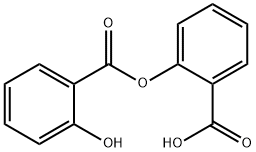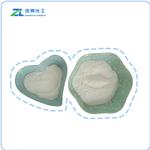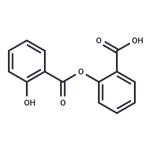Description
Salsalate, or salicylsalicylic acid, (pKa 3.5 [COOH], 9.8 [AR-OH]) is a dimer of salicylic acid. It is insoluble in gastric
juice but is soluble in the small intestine, where it is partially hydrolyzed to two molecules of salicylic acid and
absorbed. On a molar basis, it produces 15% less salicylic acid than aspirin. It does not cause GI blood loss and can
be given to aspirin-sensitive patients. Salsalate is available as capsules and tablets.
Chemical Properties
white crystalline powder
Uses
Nonacetylated (e.g., sodium salicylate) and acetylated (aspirin) forms of salicylate are widely used to target inflammation in the treatment of insulin resistance, type 2 diabetes, or rheumatic pain. Sasapyrine is a dimeric prodrug comprising two esterified salicylate moieties. It is advantageous over sodium salicylate because it is insoluble at the acid pH of the stomach and passes suspended but undissolved into the small intestine, sparing the gastric mucosa direct contact.
Uses
Nonacetylated aspirin analog. Analgesic, anti-inflammatory.
Uses
Salicylsalicylic acid is used in organic synthesis and functions as a plant hormone, as a key ingredient in topical anti-acne products.
Definition
ChEBI: A dimeric benzoate ester obtained by intermolecular condensation between the carboxy of one molecule of salicylic acid with the phenol group of a second. It is a prodrug for salycylic acid that is used for treatment of rheumatoid arthritis and osteoarthrit
s and also shows activity against type II diabetes.
brand name
Disalcid (3M Pharmaceuticals).
General Description
Salsalate, salicylsalicylic acid (Amigesic, Disalcid,Salflex), is the ester formed between two salicylic acidmolecules. It is rapidly hydrolyzed to salicylic acid followingits absorption. It reportedly causes less gastric irritationthan aspirin, because it is relatively insoluble inthe stomach and is not absorbed until it reaches the smallintestine.
Biochem/physiol Actions
Salsalate is a nonsteroidal anti-inflammatory drug (NSAID), a nonacetylated salicylate with no more problems of gastrointestinal bleeding than placebo. It inhibits synthesis and release of prostaglandins through the inactivation of cyclooxygenase-1 (COX-1) and COX-2. Salsalate is currently being investigated as a treatment for Type 2 diabetes with possible use to prevent the disease in people at risk. It reduces blood glucose concentrations in patients with type 2 diabetes, as well as in insulin-resistant patients without diabetes.





